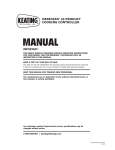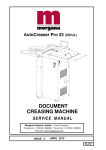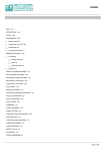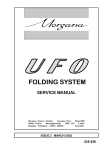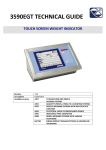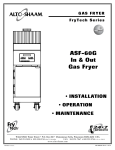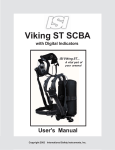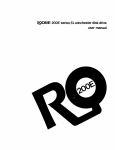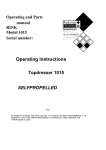Download hand fed creasing
Transcript
DigiCreaser HAND FED DOCUMENT CREASING MACHINE SERVICE MANUAL Morgana Systems Limited United Kingdom Telephone: ( 01908 ) 608888 Facsimile: ( 01908 ) 692399 Website: www.morgana.co.uk ISSUE 4 OCTOBER 2012 70-088 INTRODUCTION MORGANA DigiCreaser i ...........Introduction The purpose of this manual is to explain the procedure for dismantling and re-assembly of the major assemblies on the Morgana Digicreaser. All the engineering adjustments are shown at the end of each relevant section. Operator's adjustments and routine maintenance are explained in the appropriate operators guide which should always be used in conjunction with this manual. It is always a good idea to have a copy of the machines illustrated parts manual available when servicing, as its illustrations provide an invaluable reference to the construction of the individual assemblies used to build the machine. ii ..........Fasteners All threaded fasteners are isometric & all nuts are isometric hexagon. All screws are hardened high tensile steel. Cap head, Button head, Socket countersunk, Shoulder bolts and Grubscrews have internal hexagon drives which require isometric hexagon wrenches (allen keys). Ball drivers may be used, but care should be taken—particularly when releasing screws for dismantling—to avoid breaking the driver as they cannot cope with full tightening torques. NOTE ..... Do not substitute fasteners with low grade alternatives which may fail or become irremovable. Page 2 HAND FED CREASING DigiCreaser INTRODUCTION Pan head and Cross-head countersunk screws all have metric Taptite threads and Pozi -drive recesses. Use No.2 point Pozidriv or Supadriv drivers for all screws M4 & above, and No.1 point drivers for M3 & below. WARNING WORK SHOULD BE CARRIED OUT BY A TRAINED AND COMPETENT ENGINEER AND ALL SAFETY PROCEDURES SHOULD BE ADHERED TO. SWITH OFF MAINS POWER BEFORE COMMENCING DO NOT USE PHILLIPS DRIVERS - THESE WILL DAMAGE THE SCREWS & MAY SLIP, CAUSING DAMAGE OR INJURY. iii ........ Identification For general identification of areas of the machines, the following terms are used:Operator side (control panel facing) Rear of machine (opposite to control panel) Delivery end (to the left of the operator side) Feeder end ( on your right ) iv ........ New Machine Preparation Remove all packaging materials All metal parts, including the folding rollers have a protective coating and any excess should be removed. Connect the power cable to the mains supply. The machine requires 230V 50Hz 10 Amps or 115 60Hz 15 Amps. SYSTEM Page 3 INDEX Introduction…………………………………………………………………………. ¡ Introduction ¡¡ Fasteners ¡¡¡ Identification iv New Machine Preparation Section 1…… Covers………….…. ................................................................. Section 2 ……Main Creaser Mechanism ....................................................... Removal of Unit Section 3…….Removal /Replacement Stepper Drive Belt / Pulleys ………… Section 4…….Infeed Roller Removal/Replacement…………………………… Section 5…….Drive Hub - Replace Rubber Torsion Bush (shock absorber) Section 6…….Drive Link Refurbishment…….…………………………………... . Section 7…….Electrics………..…………………………………………………... Removal/Refitting PCBs Replacement of Joystick Controller Diagnostics Setting the Measurement System (Metric / Inch) Setting the Language (English, French, German) Digicreaser Wiring Diagram Digicreaser Control PCB Connection Diagram Section 8 …..Optical Sensors…….…………………………………………….. Section 9 …...Trouble Shooting………………………………………………… Calibration of Creasing Position Trouble Shooting Fuse Positions and Ratings Page 4 HAND FED CREASING DigiCreaser DigiCreaser HAND FED DOCUMENT CREASING MACHINE Key to photograph below 1 2 3 4 Roller tilt handle Stacker assembly The display unit Adjustable side lay SYSTEM 5 6 7 8 Back stop RH Fixed side lay Roller tilt knob Exit Guard 9 10 11 12 13 Control Panel Fuses Stacker Guide LH Stacker Guide RH Back Stop LH Page 5 SECTION 1 1.1 The Feed Table. To remove the feed table first remove the four M6 button head screws and washers. The feed table can now be slid off after removing the display unit . 1.2 The Frame Assembly. To remove the frame assembly first remove the three M4 screws along the bottom edge of the frame, under the mains input connector. Remove the two M6 screws, nuts and washers at the bottom of the frame, at the back and front of the machine next to the creaser mechanism. Remove the two pillars at the top of the frame, at the back and front of the machine next to the creaser mechanism. Unplug all the connectors from the PCBs and disconnect the wires. The frame assembly can now be carefully removed. 1.3 The Creaser Mechanism Cover. The creaser mechanism is situated towards the delivery end of the machine and is covered by a fixed and a hinged guard. To remove these guards just remove the four screws (M4 x 8 long) beneath the infeed guard. Pull off the rubber handle from the tilt lever, the infeed guard can now be lifted upwards and removed. Page 6 HAND FED CREASING DigiCreaser SECTION 2 MAIN CREASER MECHANISM REMOVAL OF UNIT 2.1 First access should be gained by removing the top infeed and outfeed guards (See Section 1) 2.2 Remove the feed table and display unit. 2.3 Detach guard micro switch by removing two screws, taking care not to drop them. 2.4 Cut and remove cable ties from cable mounting, retaining wiring loom. Ensure that the mains is unplugged. 2.5 From the rear of the machine, remove two button socket screws with their washers. 2.6 Remove the ’unlock’ knob from the front of the machine. 2.7 The unit can be lifted by two people vertically out of the frame with care. One person should be guiding the wiring and plugs to ensure they do not get trapped during the lifting. SYSTEM Page 7 2.8 Place the unit on a solid and clear bench ensuring no wires are trapped beneath the metal side plates. 2.9 Replace the unit ensuring the wiring harness is threaded as it was removed 2.10 Fit the tilt lever to the inside front frame with the bottom button head and screw in tilt knob. 2.11 Slide rear spacer bar down in position (see below). Fix the bottom screw in and align the top screw and fit loosely. Replace cable ties to mountings. Align the roller set square with the fixed lay edge while the front tilt lever is in the centre position. (Use the rear slots to adjust square) Tighten the screws and replace the top covers. Page 8 HAND FED CREASING DigiCreaser SECTION 3 REMOVAL/REPLACEMENT PULLEYS STEPPER DRIVE BELT/ 3.1 Loosen the adjuster nut from the inside unit and slide the belt off. 3.2 Loosen the securing socket set screws in the drive pulley on the roller for it to be removed (NOTE there is one screw located in a hole in the shaft) 3.3 Refitting the belt is a reverse procedure. To tighten the belt, first adjust the drive motor down to allow ‘feel’ of belt tightness; then re-adjust the motor / gear mesh to allow minimum backlash. SYSTEM Page 9 SECTION 4 REMOVAL / REPLACEMENT OF INFEED ROLLLER. 4.1 With the unit on a bench. 4.2 Remove the drive belt and pulley from the roller to be removed. (See section 3) WORKING ON THE DRIVE BELT SIDE: 4.3 Remove the three M4 posi-head taptite screws from around the bearing hole in the side plate (Drive belt side) to allow easy access to the bearing retaining rings. Remove the rings. 4.4 Slide the roller out and remove the bearing from the shaft drive belt side. The roller can be turned sideways to allow removal. Note the position of the spring washers. 4.5 Replace the roller in the reverse manner. Page 10 HAND FED CREASING DigiCreaser SECTION 5 DRIVE HUB:- REPLACE RUBBER TORSION BUSH (SHOCK ABSORBER). 5.1 Loosen grub screws in one half of hub. 5.2 Slide hub outward & remove rubber torsion bush. 5.3 Replace in reverse order. Rubber Torsion Bush SYSTEM Page 11 SECTION 6 DRIVE LINK REFURBISHMENT 6.1 Remove the drip tray by removing the four securing screws fixed to the tie bars. 6.2 Remove both tie bars and drip tray. 6.3 Remove the micro switch assembly to gain access to the rear drive link. 6.4 Using a short dumpy posi drive screwdriver, unscrew the three screws from the side of the link plate. Slide the side off (‘O’ Rings should be maintained in position). The plastic drive link can be removed by sliding it forward. 6.5 Replace the drive link and outer plate. 6.6 Re-assemble in reverse order. Link Plate Page 12 Micro Switch Assembly HAND FED CREASING DigiCreaser SECTION 7 ELECTRICS: REMOVAL / REFITTING PCB / POWER SUPPLY ASSEMBLY All the Electric controls and pcbs are located within the frame. Disconnect the mains. Remove the feed table and display unit. Unplug all plugs from the PCBs and disconnect wires. The total electronics assembly can be removed from the machine by unscrewing the four fixings. on the frame. (two screws at the bottom and two spacers at the top). POWER SUPPLY ASSEMBLY- Two Large PSU The two large PSU’s are located, mounted on a plate fitted within the frame, to remove these Follow the steps below. Using a 4mm socket with extension bar, remove the six nuts from the studs and lift clear of the m/c. Removal of individual PSU is by removal of two countersunk screws in the rear of the plate. Replace the units using the same screws, as damage will occur if longer screws are used. POWER SUPPLY- Small PSU 5/24V dc First remove the PSU assembly as above, this will give you access to the four posi pan head screws fixing the unit to the inside of the frame. BOARD REPLACEMENT. STEPPER DRIVE PCB The Stepper Driver board supplies the power to both Blade motor and main Drive motor and can be removed whilst located on the machine. Switch the mains power off. Cut cable ties and unplug the four green plugs. Take note of the two spade terminals on each board and remove. Unscrew the five fixing screws attaching the board to the frame and remove from the machine. Refitting is a reverse procedure to the above. IMPORTANT:Check that the switch positions on SW1, SW2, SW3, and SW4 are correct, see wiring diagram. . SYSTEM Page 13 Replacing the Joystick Controller Located on the leg, this switch is an assembly made up of four micro switches and an encoder which are generally very reliable once installed. Should it require replacing follow the procedure below. 1. Remove the feed table and display unit, giving access to the yellow leg, the the PCBs and the power supplies. 2. The switch is fitted to the leg with four M2.5 socket head screws, one on each corner, which can only be accessed from the inside of the frame. Undo the four screws and unplug the 5 way and 3 way green plugs from the main control board located at the rear of the machine. 3. Remove the switch and lead taking note of the route taken by the cable and the relevant cable tie positions. 4. Refitting is generally the reverse procedure but note, the cable clamping screw on the body of the joystick must be at the top as shown below. 5. Fix the cable using the same path and fixing points and plug the 5 way and 3 way green connectors into the p.c.b. CABLE CLAMPING SCREW JOYSTICK CONTROLLER Page 14 HAND FED CREASING DigiCreaser DIAGNOSTICS. To set total counter to zero. Turn the Machine on. Insert the Engineers Plug into the Socket located at the rear of the machine. Select Tools on the Display and scroll down the screen until ‘M/C TotalX10’ and a numeric value is between the Arrows. (Take note of this figure) Operate the Joystick to reset count to zero. Lift the joystick up until the start screen appears. NOTE. This also removes all stored programmes, including the ‘Lead Edge Trim’ and ‘Stretch’ settings. SET THE MEASUREMENT SYSTEM (METRIC / IMPERIAL SETTINGS). To set the measurement system for Imperial (Inch) or Metric (mm) the following procedure is necessary. Turn the machine on. Insert the Engineers Plug into the Socket located at the rear of the machine. Select Tools on the Display and scroll down the screen until ‘METRIC or IMPERIAL’ is displayed. Operate the Joystick to change the selection. Lift the joystick up until the start screen appears. SET THE LANGUAGE (ENGLISH, FRENCH, GERMAN) To set the language. Turn the machine on. Insert the Engineers Plug into the Socket located at the rear of the machine. Select ,Tools’ on the Display and scroll down the screen until ‘English’, ‘Francais’, or ‘Deutsch is displayed. Operate the joystick to change to the required language. Remove the Engineers Plug. SYSTEM Page 15 Page 16 HAND FED CREASING EARTH LEAD 75-281 BRN BL BL RED BRN GRN/YEL BL RED BRN DigiCreaser 2 3 4 6 7 8 9 11 12 13 24 49 75-210-05 JOYSTICK JOYSTICK PSU OUTPUT LEAD (75-303) DRIVE STEPPER (75-268) BLADE STEPPER 1 (75-267) SYSTEM SWITCH COIL LEAD (75-185) GUARD (76-171) BLADE HOME (76-170) CRANK ROTATION (76-169) EDGE TX (76-168) EDGE RX/JAM TX (76-167) JAM RX (76-166) ENGINEERING (75-255) JOYSTICK ASSY. (144-04-04) DISPLAY RD CRUNCH YLW RD SCR BL GRN GRN YLW ENGINEERING EDGE GRN RD 4 BL YLW 11 BLK YLW GRN BL BLADE BLADE STEPPER 8 HOME GRN RD 3 BL YLW BLK WHI DRIVE STEPPER BRN BRN BL BL GUARD 2 PSU GRN DOUBLE AIR 75-261 CONTROL BOARD MK3 DIGICREASER CONTROL PCB CONNECTION DIAGRAM SYSTEM SHEET 1 OF 2 Page 17 Page 18 HAND FED CREASING DigiCreaser SECTION 8 Cleaning Sensors With blades removed the optical sensors are accessible for cleaning on either side of the creaser unit - use a soft brush or cloth to remove any dust that may of collected onto sensor lens. SYSTEM Page 19 SECTION 9 Trouble Shooting Calibration of creasing position The length between the leading edge of the sheet and the 1st crease position can be calibrated in the event of the machine creasing out of position. Also the last crease closest to the back of the sheet can be adjusted relative to the front edge of the sheet to compensate for the inaccuracy of manufacture of the input roller diameters. The first crease should be 50 mm from the lead edge (less than 1 revolution of the infeed roller) & the last crease should be 370 mm from the lead edge. Adjust the 1st crease position as follows:Turn On machine. Insert the Engineers Plug into the Socket located at the rear of the machine. Run the machine and measure the first crease position at 50 mm. Select Tools on the Display and scroll down the screen until ‘LEAD EDGE TRIM’ and a numeric value is between the Arrows. Operate the Joystick to change the value (Left to Increase), a higher value Will move the crease further from the lead edge. (0 is a good start value) Lift the joystick up until the start screen appears. Run machine and check crease position, repeat above procedure until accurate crease position is achieved. Adjust the Last crease position as follows:Turn On machine. Insert the Engineers Plug into the Socket located at the rear of the machine. Run the machine and measure the last crease position at 370 mm. Select Tools on the Display and scroll down the screen until ‘STRETCH’ and a numeric value is between the Arrows. Operate the Joystick to change the value (Left to Increase), a higher value will move the crease further from the lead edge. (0 is a good start value) Lift the joystick up until the start screen appears. Run machine and check crease position, repeat above procedure until accurate crease position is achieved. Page 20 HAND FED CREASING DigiCreaser Section 9 Trouble Shooting Fault Reason Erratic register of the Creaser No Power or No Display Display shows Faint or unrecognizable characters No Display No Control of Menu Damaged roller surface Faulty motor Fuse Blown Check small Power supply input on CN1 Solution Replace rubber rollers Remove and replace motor assembly. Check small power supply output Voltage on Cn2 =5V dc Replace with correct value. L & N Voltages should read 240V or 110V AC Check cables for continuity to Emergency stop button. Replace Faulty wire or connection. Black lead of meter to green wire. Red lead of meter to blue wire. If supply has input but no output. Check voltage on main PCB CN6 Replace PSU If no voltage then check for damaged wire or connection. Replace as required. Check ribbon cable for Change Display PCB or Assembly. damage communication fault or Replace main PCB faulty processor. If LED1 & LED2 are lit on main PCB. Adjust VR1 (contrast) Check CN4 is correctly fitted Adjust VR2 (backlit) If still no display Change Display PCB or Assembly. If missing lines Change Display PCB or Assembly. Check Joystick wires Check Joystick Repair damaged wires or Replace Joystick assembly Switch m/c off. Black lead of meter to blue wire small PSU. Red lead of meter to each terminal CN10 (main PCB) First 4 pins will show reading of 4.7 Kohms Move joystick 4 posn. Check all pins. If any pins show 4.7 K ohms without moving joystick Suspect a fault joystick and replace the assembly. No Drive or Motors Pulsing Low or No Power Check green light is illuminated on both PSUs to Motors Check 240/110V AC input to Large PSUs ( Meter across L & N terminals) No LED on Stepper PCB Low or No Power Meter across V+ & V- of SP-150-24 reading 24V dc from PSU Meter across V+ & V- of SP-150-48 reading 48V dc Replace PSU if no or low reading Meter across V+ of SP-150-48 & V- of SP-150-24 reading 72V dc If voltage is correct but no light on stepper then check cable integrity. If Motors Run but Display Shows Check Lead No3 Check white & black wire for continuity. Operate System Switch from CN4 (bottom plug) Before Running’. of Stepper to Cn2 of Main PCB. SYSTEM Page 21 Section 9 Trouble Shooting Fault Reason Solution If Motors Run but Display Shows Check connectors ‘Operate System Switch Before Running’. If System switch activates faulty cable but display shows or terminals ‘Activate System Switch Before Running’. To Check. 5Vdc should be across pins 5 & 6 on CN2 Main PCB when System Switch is operated. Check 6 core cable from CN2 of control board to CN4 of stepper board Motors Erratic Wrongly wired Incorrect voltage Should read approx 30vdc When running Check colours with wiring diagram. Black lead of meter on tab IC13 (Stepper PCB) Red lead of meter on each pin CN3 (drive) Red lead of meter on each pin CN2 (Blade) Sensor - Transmitter Check supply voltage Black lead of meter on tab IC8 (Main PCB) Should read 1.3Vdc Red lead of meter on red wire of CN8 (Closest red wire to CN3) And also yellow wire of CN12 To Adjust these voltages Adjust VR3 Edge sensor & VR5 Jam sensor. Sensor - Receiver, Jam Check voltage 2.9Vdc Meter across Red/Black of CN12 (Obstruct Beam and Voltage will rise to approx 5 Vdc) Voltage will increase/decrease by adjusting intensity of transmitter (pot VR5) Sensor - Receiver, Edge Check voltage 0.466Vdc Meter across Red/Blue of CN8(Obstruct Beam and Voltage will rise to approx 5 Vdc) Note- Voltage will increase/decrease by adjusting intensity of transmitter (Pot VR3 or VR4 depending on SW1 switch position) Safety Circuit Faulty No Drive. Check Voltage on CN7 =11/12 Vdc To Check PCB. To Check Cable Any Switch or Wire, Open circuit will be 0Vdc Black lead of meter on tab IC8 (Main PCB) Red lead of meter on brown wire plug6 CN7 should read 12Vdc Unplug CN7 (meter set to Ohms) place probes across plug If no continuity then check each switch. Error Double Sheet Detected Check link on CN11 is correct. Slot Sensor Blade CN3 Home Position Switch Page 22 Remove plug from CN13 Replace link, check wiring diagram. Black lead of meter on Yellow (ground) Red lead of meter on Green = 0.2Vdc obstructed Approx 4Vdc not obstructed. Red lead of meter on Blue = 5Vdc Red lead of meter on Red = 1.2Vdc Check continuity across wires (make and break switch) HAND FED CREASING DigiCreaser FUSE POSITIONS & RATINGS PSU (5V / 24V) T4.0A (681-015) SPARE FUSE POSITION PSU (24V & 48V) T4.0A (681-015) SPARE FUSE POSITION SYSTEM Page 23























